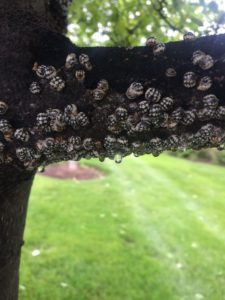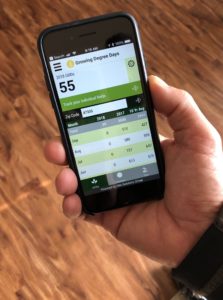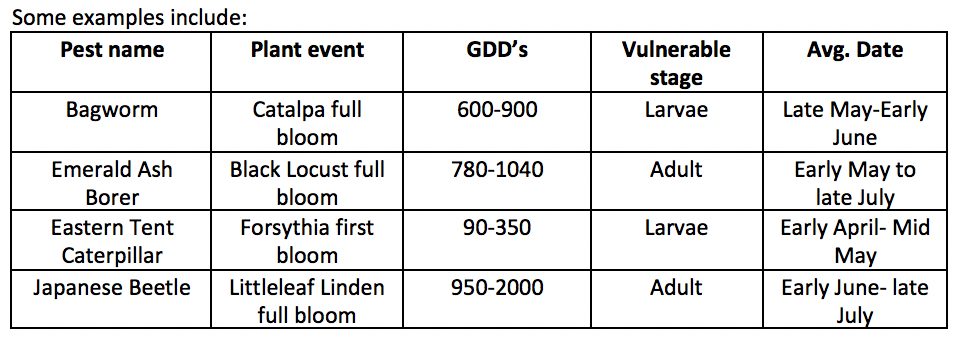When’s the best time to apply insecticides for control of bagworms? When should I expect an outbreak of scale insects on my shade trees? When is the best time to control mites? These are common questions which can be perplexing for landscapers, gardeners and plant health care professionals. Understanding plant and pest development can help provide the most effective and timely approaches to managing pests. Timing is everything and using this simple tool can ease the pain of diagnostics. Growing degree-days (GGD), while not perfect, is a more reliable method of predicting plant and insect development rather than using a calendar. Scouting for an insect may begin too early or too late if using the calendar, resulting in wasted time and missed damage on trees and shrubs.
Pests and plants are dependent on temperature to develop. They can develop and emerge earlier in warmer years than cooler temperature years. Plants also develop and bloom earlier with those “early spring’ years. Monitoring plant phenology such as bloom times can be used as a biological calendar to track degree-day accumulation and predict pest activity.
Phenology is the study of naturally recurring events in plant and insect life cycles such as bud expansion and bloom times or when scale crawlers appear on plants. Also, how seasonal variations in weather, especially temperatures, affect the timing of those events. GDD is a tool in phenology measuring heat accumulation to estimated growth stages of plants and life stages of insects. Simply stated, GDD are calculated by taking the average of the daily maximum and minimum temperatures compared to a base temperature of 50 degrees.
Calculating GDD can be a challenge and there are at least a couple of ways to determine this temperature-based function. However, there are some tools available which calculates this information for us and agricultural organizations which measure heat accumulation to provide the information necessary to make scouting and applications more effective. Also, tracking GDD is tedious and time consuming. However, phenological events can be used effectively for scheduling applications. Regardless of the time of year, bloom sequence is typically consistent with pest emergence.
Now, lets put this to work. First, it is necessary to find a reliable source for finding GDD for the target area. There are several websites available for obtaining this data which includes:
GreenCast
http://www.greencastonline.com/growing-degree-days/home
GDD Tracker
ISU Mesonet
Of course, there is an “app” for that! There are various smartphone applications which can provide GDD instantly and accurately on both platforms. Examples include Growing Degree Days, iNet Solutions Group or GDU Calculator, Ag PhD
Now, once the GDD has been determined, pest stage of development and plant phenology can be employed to determine pest appearance and vulnerability for best pesticide applications. GDD coupled with using indicator plants from the phenology charts can be a useful decision-making guide for applications.
These examples are for northern Indiana and may vary with your area, however, there is a close correspondence with phenological events. For improved accuracy in your region, local charts can be made with only one year of observations and record keeping.
Timing is everything and using GDD’s and phenological events is one of the best strategies for scouting; knowing when to expect the emergence of pests in your landscape and for timing pesticide treatments to help ensure effectiveness. This tool can help take the guesswork out of your IPM strategy and create more effective plant health programs.


